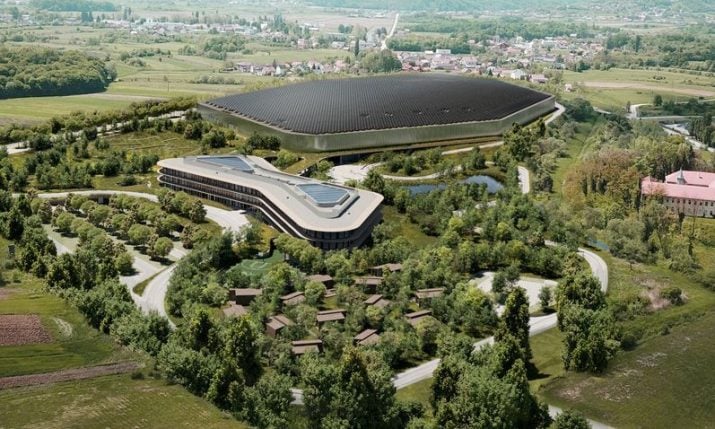The Future of Simulation is Now
- by croatiaweek
- in Business
Years ago—over a decade ago, in fact—I worked in biomedical research and I had the opportunity to see something that at the time I thought was really amazing, a simulator program for anesthesiology residents to practice maintaining a patient in surgery under general anesthesia. The doctor was provided on the computer screen with all the patient’s vital signs he would have access to on intraoperative monitors and the computer program was designed to throw in various emergencies now and then so even if the doctor maintained the patient correctly, sometimes some issue would arise that he would then have remedy. The data behind the simulation was gained from the study of actual complications in various surgeries and what is more, patients could be varied by gender, age, and underlying medical conditions as well as their current illness or injury that was being corrected via the surgery at hand. This software drew on a wealth of data to provide the resident physician with what at the time seemed like a very realistic training experience. The only thing missing, to a degree, was that the graphic user interface was a bit lacking. The doctor was only provided the vital signs of his patient as these would appear on his intraoperative monitors—no image of the patient or surgery or operating theatre at all. True, these were the main forms of data the physician would require to make his decisions with a real patient, but some willing suspension of disbelief was required to feel like you were truly working with a real patient. One of the professors who designed this simulator commented to me that as pleased as he was overall with the results, someday he hoped to see a version that would “really make the trainee doctor feel he was there, in the middle of that operation”.
That day is finally here, more or less. Techniques of visual reality for computer simulation software have grown greatly in sophistication and depth in the course of just a decade, and technologies developed for the visual effects industry catering to film and television and the complexity of video games for home gaming consoles have brought about a revolution in both the capacities of such simulations and also the attention paid to their development and realism alike. The video game industry, once seen as a poor cousin to film and television, now is a multi-billion-dollar industry in itself. Some major video games such as the popular Grand Theft Auto franchise can cost as much as a motion picture to produce, feature major recording artists on their soundtracks, and earn as much revenue as a blockbuster film would garner. While these technologies for simulation expectedly were developed in the gaming and film industries, they have spread in their maturity to many other, diverse, areas. Aside from the aforementioned medical training applications, all manner of complex systems training—from flight simulators for pilots to similar simulators for bridge officers of oil tankers to even simulations of entire nuclear power plant control rooms, we are able now to provide the highest level of realism to people being trained in complicated, dangerous, tasks without having them even set foot into a cockpit or the bridge of a ship. Obviously, the Air Force officers who fly the hotly-contested unmanned aerial vehicles—or drones—are trained via simulators and then continue to fly the drones using computers that are in effect a simulator or remote control station, as these pilots can operate thousands of miles away from the aircraft they actually control. When I was in high school, I was in the United States Air Force’s Junior Reserve Officer Training Corps—a cadet program for high school students interested in military service. At the time, our instructor who was himself a former fighter pilot, saw no cause for the need for future Air Force pilots (flying planes they occupied in the traditional manner) to decrease but felt such need would instead only increase. Drones have changed that, and the training that even the pilots who still do fly manned aircraft now are provided is highly simulator-based and uses technology that our good major never had access to in his own career as a military pilot.
Perhaps most encouraging for those interested in the future of simulation technology either on the technological or business level is that this field, which once was considered at best supportive to larger industries (such as aviation training) is now a bona fide industry unto itself. The very latest in nuclear power plant simulation by companies such as L-3 MAPPS involves mock-up control rooms that mirror every single indicator, every dial, and every control switch that is found in the real control room for that plant. The computer simulation hiding behind this ever-so-detailed environment however is what makes the simulation really shine: the computer software can mimic any possible situation the real plant could encounter and in doing so, will cause the exact same indicators and data-flow that operators in the control room would be required to respond to if these same events transpired in real life. When sitting in such a simulated control room, there is absolutely no indication that one is not in fact in the real control room. This way, employees can train in an environment that is verbatim how their actual work environment will appear and how its systems will interact with the operators’ actions. When I speak of “simulations” or “simulators” to many people, they often think of a computer game and at that, often the outdated games of the 1990s or even the 1980s. When you tell them that someone operating a nuclear reactor is trained on a simulator they may envision him simply staring into a computer monitor much like the anesthesiology residents mentioned above, but these days, the simulator is so sophisticated, so realistic, that there is fully no difference between it and the real thing. That is essential, because this type of immersive simulation allows staff in training—whether nuclear reactor operators or pilots—to be apart from working professionals and in a training-dedicated environment and one where every action they take can also be recorded and analyzed by instructors as to how they can improve their performance. That’s a fundamental and breath-taking advance in industrial pedagogy compared to how people in many fields that use such simulation now used to be trained in the past. At one point, in example, airline pilots who were training on a specific type of aircraft (model of airliner, e.g., Boeing 747) would have to go up in the aircraft and actually practice landings and other duties with the real aircraft, using valuable resources, fuel, and time in a way that is now replaced largely by simulators just as sophisticated as the aircraft they represent.
There is another type of simulation however and it’s an area where just as much progress is being made as in the type of simulation described above that is geared towards education and training. This second arena of simulation is that of modeling processes or systems that, if not modeled in the computer, would be very expensive to model otherwise or possibly even impossible to research. Examples of this would include structures being tested for new aircraft and aircraft materials; the testing of various configurations for space stations, spacecraft, or satellites; and the testing of how various systems aboard a complex ship such as an aircraft carrier or submarine may work together. Using a combination of cutting-edge computer simulation and real-world lab-based testing, engineers at NASA’s Marshall Space Flight Center’s Nuclear Thermal Rocket Element Environmental Simulator are working on designing a nuclear-powered rocket that one day could be used to take a manned spacecraft to Mars or even further and would boast numerous advantages over traditional chemical-based rocket propulsion. Using an on-board nuclear reactor to super-heat hydrogen to extraordinarily high temperatures, this system of propulsion could solve several of the problems found in conventional rocket engines. While much of the testing must be done using conventional materials to stand in for nuclear ones in a traditional laboratory situation, computer simulation greatly helped the scientists involved calibrate these materials to their best realizations and then factor in what parameters needed to be examined in the lab testing. One can surmise the computer work also probably saved much time and money in the real-material lab phase of testing, too.
One may think of the role of contemporary computer simulation in the service of testing applications this way: we all know of the engineer working with plans and calculations at his desk or drafting table, and we also know of the testing in wind tunnels or labs that has to be done in designing new aircraft or the like: in between these two phases of the research and development process enters the computer simulations that will allow for faster, often more-exact, and likely cheaper exploration of essential parameters and situations. That applies to everything from aircraft and spacecraft to new cars to even more mundane products such as household goods. However, for the most-advanced of complex technologies—things like the nuclear rocket engine described above—simulation is key because it allows more-nuanced exploration of important details that cannot be figured out via any other viable means. Indeed, the concept of a spacecraft with nuclear propulsion was first explored by NASA in the 1960s and 1970s, but at that time the lack of such sophisticated simulation modalities meant that many factors were not easy to examine. For that and other reasons, the technology to make such a rocket system viable simply was not yet available and the project could not move ahead. Now, we have the necessary technologies to produce accurate simulations and expand on such projects with success.
Croatia is a nation that has a very high level of native technical expertise and quality education in math, the sciences and the engineering disciplines. There is a robust and ever-growing market for new technologies serving the simulation field and also in new direct applications for simulatory approaches. While there has been a huge push worldwide towards more emphasis on general software development, even down to apps for smartphones and the like, there has been much less emphasis on the overall development of simulations-oriented technologies despite the growth in this area. Moreover, like most areas of software, many areas of simulation technology are less costly to invest in as a young company: the people involved and the ideas they are pursuing are the most crucial aspects to the success of the business and expensive outlays for things such as factories, transport, or retail locations are not a concern. Simulation-based technologies, which are mainly software-oriented but do also include hardware (and in some cases, such as the simulators for the nuclear power plant control rooms, obviously very expensive, dedicated, and complex hardware) are only going to grow as more industries find value in applying simulations to their needs for training and/or product testing and development.
This is an area of business that frankly can be established anywhere in the world where well-educated people can be found and connections to related industries are easily possible. There is no reason to think that Croatia cannot become such an area. We have already seen great growth in the software field in the Balkans and Russia over the past few years, yet many of the start-up companies involved seemed more focused on smartphone or tablet apps—consumer software that may provide ease of development and early success in revenue, but is not likely to be a long-lasting source of sustained income. In the academic arena, we see many institutes interested in simulation and associated concerns such as robotics, but many of those in Russia are sadly narrow in their core focus: in example, the Russian State Scientific Center for Robotics and Technical Cybernetics has for years produced innovative research but now is focused greatly on robots and systems to be employed in searching for rogue nuclear weapons and related activities. The thinking here appears to still be an approach left over from the Soviet years: the military community is the primary customer for much of what this institute still produces. Truly, there is a need for that area of research, but there are many other and more commercial applications for such technologies and these appear in many Russian academic institutes and labs to be overlooked. For Eastern Europe therefore, there is even more reason to believe that another nation could step in and take the lead in areas germane to simulation where Russia, the traditional technological innovator in the region, has for whatever decided to not focus the wealth of its efforts. Croatia is well-suited in terms of basic resources—the educational potential, the know-how, the international connections, the central location and communications/trade routes—to explore simulation as a growing field of business development.











